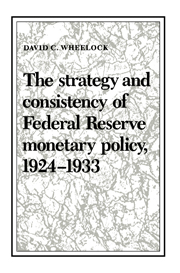Book contents
- Frontmatter
- Contents
- List of Figures
- List of Tables
- Preface
- 1 Introduction
- 2 The objectives of monetary policy, 1924–1933
- 3 Member-bank borrowing and the Fed's policy strategy
- 4 Policy disagreements within the Federal Reserve System: the effects of institutional change
- 5 Conclusion
- Appendix: Variable definitions and data sources
- References
- Index
5 - Conclusion
Published online by Cambridge University Press: 11 September 2009
- Frontmatter
- Contents
- List of Figures
- List of Tables
- Preface
- 1 Introduction
- 2 The objectives of monetary policy, 1924–1933
- 3 Member-bank borrowing and the Fed's policy strategy
- 4 Policy disagreements within the Federal Reserve System: the effects of institutional change
- 5 Conclusion
- Appendix: Variable definitions and data sources
- References
- Index
Summary
The failures of Federal Reserve policy making during the Great Depression cannot be attributed to a single cause. Flaws in the System's organization, goals, and methods all contributed to its mistakes. The System's decentralized organization slowed the Fed's response to crises and made consensus difficult to achieve. Its goal of maintaining the convertibility of the dollar into gold caused the Fed to take deflationary actions in the midst of the depression. And the failure of policy makers to interpret monetary conditions correctly caused them to believe that money and credit were plentiful while the banking system and money supply were collapsing.
In their Monetary History of the United States, Friedman and Schwartz (1963) argue that under the leadership of Benjamin Strong, Governor of the Federal Reserve Bank of New York, policies were developed that successfully limited fluctuations in economic activity. But Strong's death in 1928 and a subsequent reorganization of the Open Market Committee redistributed authority to officials who lacked the knowledge and experience to continue Strong's policies. Consequently, there was a dramatic change in Federal Reserve responsiveness to economic conditions. According to Friedman and Schwartz (1963, pp. 411–14), Strong would have prevented reorganization of the Open Market Committee, and his experience as an officer of Bankers Trust Company during the Panic of 1907 foretold that he would have reacted vigorously to the banking panic in 1930.
- Type
- Chapter
- Information
- Publisher: Cambridge University PressPrint publication year: 1991



